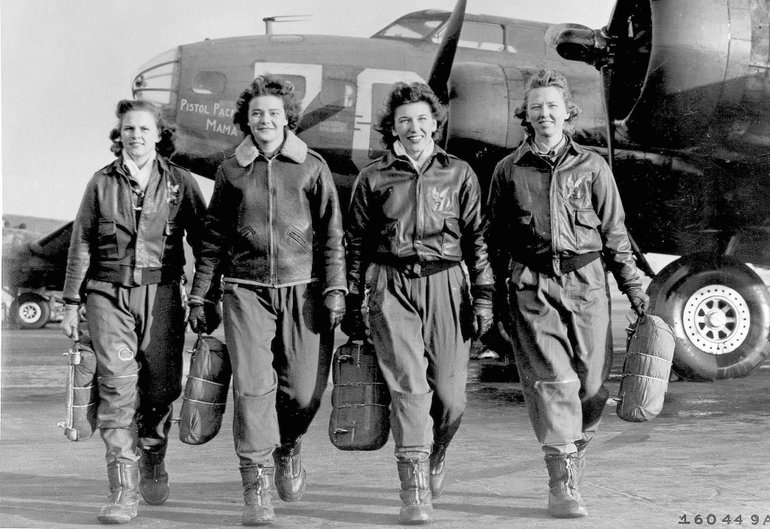Blanche Bross was a “Pistol Packin’ Mama.” That was the name of the B-17 bomber frozen in time behind her, anyway.
Helen Johnson just wanted to fly, and volunteering for a WWII women’s aviation program gave her the chance.
Both Clark County women were members of a unit that was saluted Wednesday by Congress, although neither local aviator lived long enough to see the recognition.
Bross, a Vancouver resident who died in 2008 at the age of 92, and Washougal’s Johnson, who died in November at 94, were among 1,000 Women Airforce Service Pilots who flew military aircraft during the war.
About 200 women in their 80s and 90s attended the ceremony in the U.S. Capitol building, where they received the Congressional Gold Medal — the highest civilian honor given by Congress. Each woman received a bronze duplicate of the original gold medal.
The women volunteered for noncombat duty, freeing up men pilots for combat duty.
They ferried planes across the country, towed targets for gunnery training and instructed airmen.
The women were considered civilians. When the unit was disbanded in 1944, many of the women had to pay their own bus fare home. They didn’t get veteran status until 1977.
But more than 60 years ago, they were happy to fly while serving their country, Bross and Johnson told Columbian reporters in 2006.
“It was just an exciting privilege to fly,” said Bross, who piloted a B-17.
While growing up on a dairy farm outside Washougal in the 1930s, Johnson said, she was captivated by the sound of biplanes cruising overhead.
Unlike male pilots, the women had to know how to fly when they volunteered for the WASPs. Johnson made her first solo flight in 1939 when she attended what was then Washington State College.
“Then, when I came home, I couldn’t fly for a couple years because everything was blacked out, and there was no private flying in the war,” she said in 2006.
In 1944, she became a WASP.
“It was a love of flying I had,” she said. “I applied, and was lucky enough to get into the WASP and go to Sweetwater, Texas, near Lubbock, in 1944, to fly in the wind and the sand.
“Once in a while, we’d get lost, and land in Oklahoma,” she said, laughing. “But we always got back all right.”
Bross’ brother -in-law taught her to fly in Eugene, Ore.
Bross climbed into the cockpit with a height advantage.
“Being 5-foot-8 really helped a lot,” she explained, since shorter women had trouble reaching the pedals.
On some training flights, she flew a B-17 as airmen learned how to fire the Flying Fortress’ .50 caliber machine guns. On other flights, she towed targets so anti-aircraft gunners could practice firing at objects in the air.
Bross became part of an iconic image that did give the women some recognition. The photograph shows four WASPs, parachutes in hand, walking away from a B-17 bomber with “Pistol Packin’ Mama” painted on the nose.
The photo hangs in one the Smithsonian Institution’s museums in Washington, D.C. Bross said she doesn’t remember the day it was taken, but it’s her favorite. It’s since shown up in all kinds of advertisements and in all kinds of museums. “It just started appearing and appearing,” Bross said.
Now Bross, Johnson and their wartime comrades are getting a more public salute.
“The Women Airforce Pilots are unsung members of ‘The Greatest Generation,’” U.S. Sen. Maria Cantwell, D-Wash., said Wednesday. “They were trailblazers who had a tremendous impact on the role of women in the military today.”
Calling the medal “long overdue recognition for their courage, loyalty and service to our nation,” Cantwell said, “These women brought about a historic change in our armed services and our nation.”
Thirty-eight women pilots died on duty. Sen. Kay Bailey Hutchison, R-Texas, one of the lawmakers who led the push for recognition, said in an Associated Press story that it was fellow female aviators who helped pay the funeral expenses for many of those WASPs.




